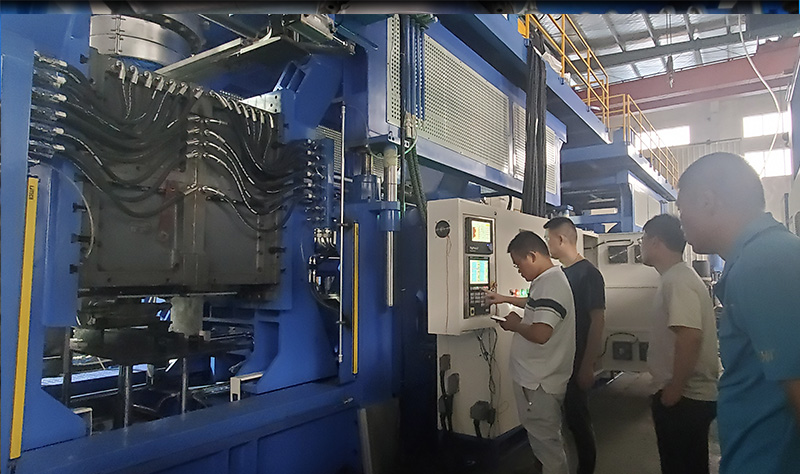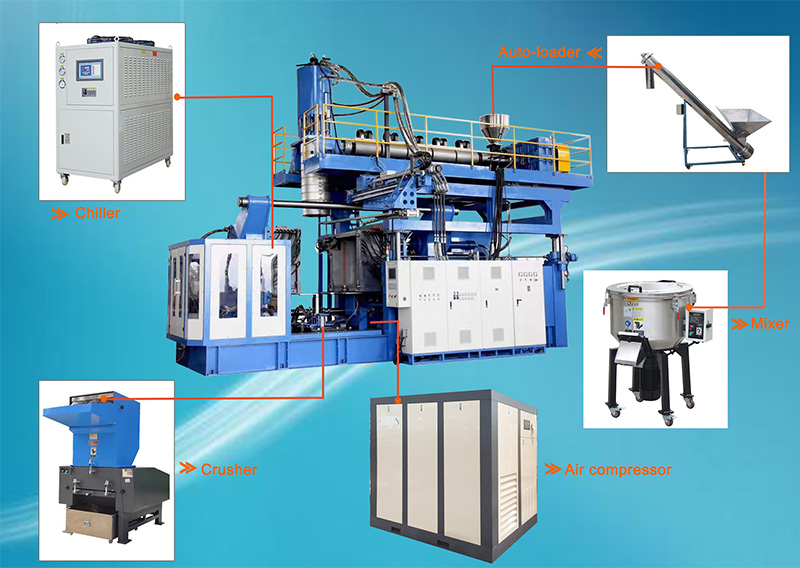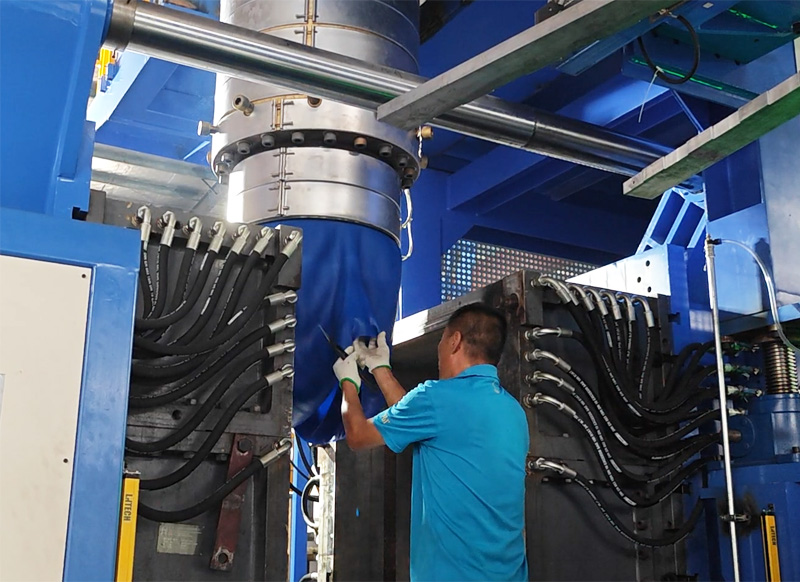
In the dynamic world of IBC blow molding, wall thickness uniformity holds the key to success. The precision in achieving consistent wall thickness is not just a technical detail; it is a critical factor that directly impacts product quality and performance. As manufacturers, we understand the paramount significance of this aspect and are committed to delivering excellence in IBC tank production.
In this article, we delve into the crucial role of wall thickness uniformity, exploring its impact on product quality and performance. We will highlight the importance of adopting a strategic roadmap that paves the way to precision and reliability in IBC blow molding. Join us on this journey as we uncover the potential for improved efficiency, reduced waste, and heightened competitiveness through mastering wall thickness uniformity in IBC blow molding. The path to excellence begins with precision, and we invite you to explore this transformative approach with us.
Identifying the Root Causes of Uneven Wall Thickness:
Ensuring uniform wall thickness in IBC blow molding is an intricate process that demands a keen understanding of the various factors at play. By analyzing the following common factors that contribute to inconsistent wall thickness, manufacturers can begin to address the root causes and work towards achieving precise and consistent results.
1. Machine Settings:
The settings and parameters of the blow molding machine play a crucial role in determining the final wall thickness of the IBC tank. Variations in temperature, pressure, and blow time can lead to irregularities in the material distribution during the molding process. Identifying the optimal machine settings and calibration is fundamental to maintaining a uniform wall thickness throughout the production run.


2. Material Properties:
The characteristics of the raw materials used in the blow molding process significantly impact wall thickness uniformity. Variations in material viscosity, density, and melt flow index can result in uneven material distribution within the mold. Selecting high-quality and consistent materials is a critical step in achieving precision in IBC tank production.
3. Cooling Methods:
The cooling process is crucial in stabilizing the shape of the IBC tank after the extrusion blow molding phase. Inadequate cooling or uneven cooling rates can lead to warping and variations in wall thickness. Implementing efficient cooling methods and ensuring consistent cooling throughout the mold are essential to achieving uniform wall thickness.
Pinpointing Specific Challenges in the Extrusion Blow Molding Process:
Extrusion blow molding, while highly efficient, poses unique challenges that can affect wall thickness uniformity in IBC tanks.
1. Parison Control(GEFRAN,MOOG):
The parison, a hollow tube of molten plastic, is formed during the extrusion process and inflated to create the IBC tank. Inconsistent parison control can lead to variations in material distribution, resulting in uneven wall thickness. Tight control over the parison formation is essential to achieving precision in the blow molding process.


2. Wall Stretching:
During the inflation phase, the parison undergoes stretching, which can impact wall thickness uniformity. Uneven stretching or excessive stretching in specific areas of the tank can lead to thinning or thickening of the walls. Controlling wall stretching and ensuring uniform expansion of the parison are critical in achieving consistent wall thickness.


Understanding the Impact of Operator Skill and Expertise:
While advanced technology and automated systems are invaluable in blow molding, the expertise and skill of the operators cannot be underestimated. Operators play a pivotal role in fine-tuning the process, making real-time adjustments, and ensuring the quality of the final product.


1. Training and Skill Development:
Providing comprehensive training to operators is essential in cultivating their expertise in blow molding. Knowledge of machine operation, material properties, and troubleshooting is critical in maintaining consistency in wall thickness.
2. Real-Time Monitoring and Adjustment:
Operators must be vigilant in monitoring the blow molding process and making necessary adjustments to optimize wall thickness. Their ability to identify and address potential issues during production contributes significantly to achieving uniform wall thickness.
By acknowledging and addressing these root causes, manufacturers can pave the way for precise wall thickness uniformity in IBC blow molding. A combination of optimized machine settings, material selection, cooling methods, parison control, and skilled operators creates a holistic approach that ensures exceptional product quality, customer satisfaction, and ultimately, success in the IBC tank manufacturing industry.


Material Selection and Preparation:
In the quest for achieving wall thickness uniformity in IBC tank production, the choice of materials and their preparation plays a pivotal role. Addressing material-related challenges and implementing the right techniques are fundamental steps in attaining precision and consistency.
1. Choosing Suitable Materials with Consistent Properties:
Selecting the right materials is the foundation of achieving uniform wall thickness in IBC tank production. Manufacturers must carefully evaluate various plastic resins, considering factors such as melt flow index, density, and thermal properties. Opting for materials with consistent properties across production batches ensures a more predictable and stable blow molding process.
2. Importance of Material Homogenization and Processing Conditions:
Material homogenization is a critical step in preparing raw materials for IBC tank production. Proper mixing and blending of materials ensure a consistent composition, minimizing variations in material properties that could affect wall thickness distribution. Manufacturers must establish strict material homogenization protocols to ensure each IBC tank produced adheres to precise specifications.

Moreover, controlling processing conditions during material preparation is vital. Factors such as melting temperature, extrusion rate, and cooling rate must be meticulously monitored to maintain uniformity in the molten plastic. Implementing precise control over processing conditions allows for consistent material flow during the blow molding process, resulting in even wall thickness across the entire IBC tank.
By selecting materials with consistent properties, homogenizing materials effectively, and closely monitoring processing conditions, manufacturers can mitigate material-related challenges and set the stage for precise wall thickness uniformity in IBC tank production.
In the quest for mastering wall thickness uniformity in IBC blow molding, material selection and preparation play a pivotal role. Opting for materials with consistent properties, implementing stringent material homogenization protocols, and maintaining precise control over processing conditions are essential steps in achieving precision and consistency.
As manufacturers embrace the importance of material-related factors, they pave the way for a successful roadmap towards precision and excellence in IBC blow molding, ultimately defining their success in the dynamic and demanding world of IBC tank manufacturing.


Optimizing Cooling and Cooling Rate Control:
Cooling is a critical stage in the blow molding process that significantly impacts the final wall thickness uniformity of IBC tanks. By highlighting its significance, implementing effective cooling rate control strategies, and leveraging advanced cooling technologies, manufacturers can achieve superior wall thickness consistency and elevate the overall quality of their IBC tanks.
1. Highlighting the Significance of Cooling in the Blow Molding Process:
Cooling plays a crucial role in shaping the IBC tank after the extrusion blow molding phase. Proper cooling is essential to solidify the molten plastic and maintain the desired shape and dimensions. Inadequate or uneven cooling can lead to warping, stress, and, consequently, variations in wall thickness. As a result, precise control over cooling is imperative to achieve uniform and dimensionally stable IBC tanks.
2. Implementing Strategies to Control Cooling Rates and Minimize Thermal Variations:
Controlling the cooling rates during the blow molding process is a strategic approach to achieving consistent wall thickness. Manufacturers must carefully assess the cooling requirements of each IBC tank design and optimize cooling conditions accordingly. Strategies include adjusting cooling time, airflow, and temperature distribution throughout the mold to ensure even and controlled cooling.
Moreover, minimizing thermal variations is essential to prevent discrepancies in wall thickness caused by temperature fluctuations. Insulating the mold and maintaining a stable operating environment contribute to a more controlled cooling process, reducing the risk of non-uniform wall thickness.


3. Showcasing Advanced Cooling Technologies that Enhance Wall Thickness Uniformity:
Innovation in cooling technologies has revolutionized blow molding operations, offering manufacturers new tools to enhance wall thickness uniformity. Advanced cooling systems, such as conformal cooling and rapid cooling techniques, have emerged as game-changers in the industry.
Conformal cooling involves the design and integration of cooling channels that precisely match the contours of the mold, optimizing cooling efficiency and reducing thermal variations. This revolutionary technique ensures consistent cooling across the entire mold surface, resulting in IBC tanks with uniform wall thickness and enhanced dimensional stability.
Similarly, rapid cooling technologies leverage advanced cooling agents, such as liquid nitrogen, to achieve faster and more uniform cooling rates. By rapidly solidifying the molten plastic, these technologies contribute to improved wall thickness consistency and reduced cycle times.
Optimizing cooling and cooling rate control in the blow molding process is a key aspect of achieving precise wall thickness uniformity in IBC tank manufacturing. Manufacturers must recognize the significance of cooling and its impact on the final product quality. By implementing strategies to control cooling rates and minimize thermal variations, manufacturers can ensure even and consistent cooling throughout the molding process, leading to IBC tanks with superior wall thickness uniformity.
Leveraging advanced cooling technologies, such as conformal cooling and rapid cooling techniques, further enhances wall thickness uniformity, setting a new standard of excellence in the industry. As manufacturers embrace these cooling innovations and strategies, they equip themselves with the tools to deliver high-quality, dimensionally stable IBC tanks, meeting the demands of the market and exceeding customer expectations. The optimization of cooling processes marks a critical step in the journey to redefine IBC blow molding with precision and efficiency.


Operator Training and Skill Development:
In the pursuit of precision and consistent wall thickness in IBC blow molding, the role of skilled operators is paramount. Manufacturers must recognize the critical impact that operators have on the quality of the final product. By providing comprehensive training programs and fostering a culture of continuous improvement and skill development, manufacturers can elevate the expertise of their operators, resulting in exceptional wall thickness uniformity and overall manufacturing excellence.
1. The Role of Skilled Operators in Achieving Precision and Consistent Wall Thickness:
Operators are the backbone of the blow molding process, responsible for overseeing and fine-tuning the production line. Their expertise in machine operation, material handling, and problem-solving directly influences the outcome of the IBC tank's wall thickness. Skilled operators can detect and address potential issues in real-time, ensuring uniformity throughout the production run. Investing in skilled operators is investing in the success of the entire manufacturing process.
2. Providing Comprehensive Training Programs to Enhance Operator Knowledge and Expertise:
To equip operators with the necessary skills, manufacturers must offer comprehensive training programs that cover all aspects of IBC blow molding. Training should encompass machine operation, material properties, mold setup, and troubleshooting techniques. Operators should be trained to interpret data, monitor the blow molding process, and make informed adjustments to maintain precision in wall thickness. Regular refresher courses and hands-on training sessions reinforce their expertise and confidence.


3. Encouraging a Culture of Continuous Improvement and Skill Development:
Fostering a culture of continuous improvement is pivotal in achieving excellence in IBC blow molding. Manufacturers should encourage operators to actively participate in process optimization, identifying opportunities for enhancement and innovation. Open communication channels between operators and management enable the exchange of ideas and insights, fostering a dynamic environment for improvement.
Encouraging a culture of continuous improvement empowers operators to actively contribute to process optimization and innovation. The collaboration between skilled operators and management creates a synergy that drives the success of the blow molding process. As manufacturers prioritize operator training and skill development, they pave the way for a future of precision and excellence in IBC blow molding, solidifying their position as industry leaders and satisfying the demands of discerning customers.
In conclusion, precision in wall thickness uniformity is of utmost importance in IBC blow molding. Manufacturers must recognize the impact of consistent wall thickness on product quality and performance. By following the strategic roadmap and embracing advanced strategies, they can achieve the desired level of precision and reliability.
The benefits of mastering wall thickness uniformity extend beyond product quality. Manufacturers can experience improved efficiency, reduced material waste, and heightened competitiveness in the market. Embracing precision in IBC blow molding is not just a technical goal; it is a pathway to success and customer satisfaction.
As the industry evolves and demands for superior products grow, manufacturers who prioritize precision and invest in advanced techniques will rise as leaders. By focusing on wall thickness uniformity, manufacturers can redefine IBC blow molding, leaving a lasting impact on product quality, operational efficiency, and overall market presence. The journey to precision begins now, and its rewards are well worth the pursuit.





















